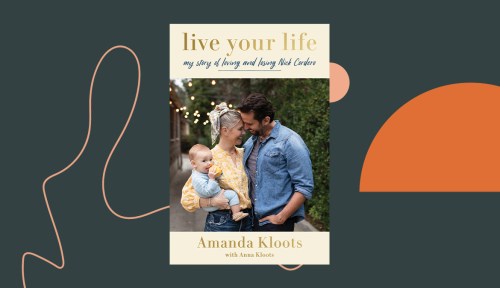Our editors independently select these products. Making a purchase through our links may earn Well+Good a commission
With a career trajectory that’s landed her on stage or on camera at every turn—from being one of the Radio City Rockettes and a Broadway performer to a Well+Good Trainer of the Month and her current role as a co-host of The Talk on CBS—Amanda Kloots knows a thing or two about putting on a happy face for a crowd. But it was her experience losing her husband, Broadway star Nick Cordero, to COVID-19 that taught her what it really means to smile through pain.
Experts in This Article
trainer and founder of AK! Fitness
When Cordero was in the hospital in spring 2020, Amanda began sharing her grieving process on Instagram in her classic glass-half-full fashion by posting hopeful messages on a near-daily basis. She continued doing so after he passed away in July, garnering a community of supportive followers drawn to her infectious positivity, even in the most harrowing of circumstances.
This week, she released a memoir with her sister, writer Anna Kloots, in which she explores her grief journey, called Live Your Life: My Story of Loving and Losing Nick Cordero. In the latest episode of the Well+Good Podcast, Amanda delves into the person she is behind those Instagram posts and book pages, and how she’s learned to move through grief with a renewed sense of joy.
Listen to the episode here:
Amanda says she’s naturally inclined to take the positive path over the negative—“That’s just my brain chemistry,” she says in the podcast—and that reality has been important for her to honor since Cordero’s passing, especially given outsiders’ opinions of how grief should look. “About two weeks after Nick died, I posted some outdoor workout that I was doing, and people were like, ‘I can’t believe you’re smiling and working out so soon after your husband passed away,’” she says. “And I was like, ‘So, you’d rather have me in a ball, crying and shivering and shaking and not being able to move? That’s not what Nick would want.’”
“I know that Nick, if he could have told me anything when he was passing, he would have said, ‘You better not just do nothing. You better move forward. You better find love again.’” —Amanda Kloots
Dealing with grief is a personal journey that doesn’t need to align with the concerns of others, and understanding that truth has helped Amanda to stay grounded throughout her grief process. It’s honoring Cordero’s memory in ways he would’ve loved that’s helped her forge a functional path forward. “I don’t feel guilty about moving forward, as I know I’d feel guiltier if I wasn’t,” she says. “I know that Nick, if he could have told me anything when he was passing, he would have said, ‘You better not just do nothing. You better move forward. You better find love again.’”
That thought process has inspired Amanda to re-engage in the same things that she’s always enjoyed, even in the midst of her grieving process, from baking cookies to practicing dance cardio and doing her beloved jump-rope workouts. And in doing so, she’s become even more appreciative of what she has, rather than focused on what she’s lost. “It makes you count your blessings, and those blessings bring joy,” she says.

Getting back into a routine can also help you escape the state of limbo and upheaval that comes after the death of a loved one, her sister Anna says in the podcast: “The fear of what the next unknown thing is going to look like can be worse than just diving back in.”
But of course, reverting quickly to what your life was like before losing a loved one may not be right for everyone, as again, every passage through grief is personal. “It’s your own roller coaster, and you just have to get in the cart and go,” Amanda says. “Some people ride with their hands up, and some people grip the bar the whole time.” What’s important to remember is that both methods are entirely valid.
Listen above, and subscribe to The Well+Good Podcast on Apple, Spotify, or wherever you get your podcasts.
Sign Up for Our Daily Newsletter
Get all the latest in wellness, trends, food, fitness, beauty, and more delivered right to your inbox.
Got it, you've been added to our email list.










